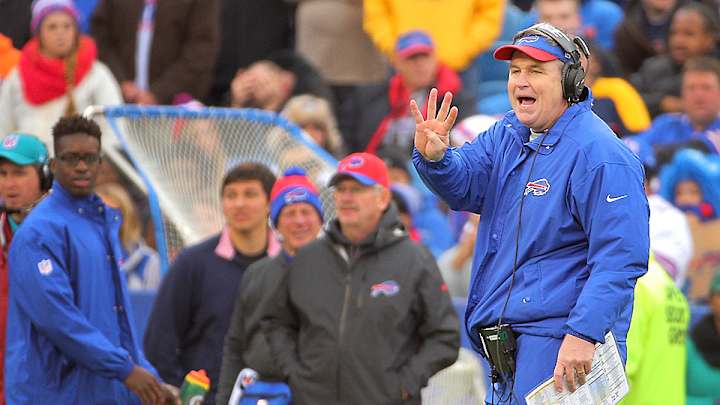To Be the Man in Charge ...

Two months away from NFL player movement, the business of football now shines a spotlight on the coaches. In these weeks immediately following the regular season, they’re being fired, opting out, getting hired and forcing organizational changes.
Having been around two coaching changes with the Packers, I know how the decision impacts so many people beyond the head coach. Assistant coaches now exist in a state of limbo, talking to their friends in the coaching fraternity and scouring the internet for rumors of who’s going where. Meanwhile, wives and families try to plan for various scenarios regarding relocation: housing, insurance, school changes for children. It is an anxious and uncomfortable time for all involved.
As for the hiring process, my view is that it should be as thorough and comprehensive as possible. This is hopefully a decision that will last a long time, so a team might as well use the opportunity to do it done right rather than do it quickly. This is also a time when teams can gain competitive edges by picking the brains of coaches and executives from other organizations—something I always tried to do—and coopting those the best methods and practices. The interview season, in essence, presents legal tampering opportunities.
Before getting into some of the coaching situations that recently played out in the NFL, let’s examine how the money works when coaches are terminated. Their contracts, that is. Not them.
Coaching contract conundrums
Reflections on Wild-Card Weekend
1) The story of Rams owner Stan Kroenke buying 60 acres in a prime stadium location in Los Angeles was largely ignored a year ago. When asked about it at his Super Bowl press conference last year, Roger Goodell said something to the effect of, u201cStan is very wealthy; he buys a lot of land.u201d Of course, it was more than that. And Sam Farmer of the Los Angeles Times, who is very tied into the NFL, has revealed that. This story has a lot of chapters left, but the Rams have clearly taken the lead in the race for Los Angeles. 2) I am still amazed at who the injury-plagued Cardinals trotted out in their offensive backfield. That backfield would normally be playing in the second half of a preseason game, not a playoff game. Even presumed Coach of the Year Bruce Arians cannot coach his way to victory with third-tier talent. 3) The pairing of Jerry Jones and Chris Christie has a lot of layers to it, but the one interesting to me is that they are adversaries in ongoing litigation in New Jersey. The NFL, composed of owners such as Jones, has been in New Jersey court stridently opposing Christie’s attempts to allow for sports betting in racetracks and casinos in the state. The sight of these two legal adversaries hugging in the owner’s box is, well, amusing. 4) I received the predictable slew of questions about Andy Dalton’s contract during and after the Bengals’ loss. Here’s the answer: it is essentially a two-year, $25 million deal, which is still too much for many Bengals fans. But to those I ask: What exactly were/are the alternatives at quarterback? 5) I have seen officials throw a flag and then pick it up—something that seems to be happening more and more—but never after publicly announcing the penalty, as it happened with the infamous pass interference non-call in the Cowboys-Lions game. Putting aside whether a foul occurred or not, the unsatisfying explanation reflects poorly on the NFL (to say nothing of Dez Bryant’s non-penalized helmetless run onto the field to protest the initial call.) Although head of officiating Dean Blandino’s visit to Jerry Jones’s bus earlier this year is certainly unrelated, the appearance of impropriety—real or perceived—exists. For a league where credibility has been an issue this year, this does not help. — A.B.
The nonunion NFL coaches have better contractual security than the unionized players. The vast majority of coaching contracts are guaranteed throughout the length of the deal, subject to 1) not being fired “with cause” due to some sort of material breach of the contract, and 2) offset language, reducing the firing team’s financial obligation by amounts received from a new team during the remaining term of the contract.
Offset clauses can present sticky situations and lead to disputes. The language requires the coach to use “due diligence” in obtaining another coaching position (rather than just sitting and collecting the firing team’s checks). There have been situations where teams have tried to avoid paying coaches whom they perceive as deliberately choosing not to work rather than taking an available though not optimal job.
Another offset issue that triggers disputes involves new teams paying fired coaches and front office executives below-market value, because the fired employee is only too willing to stick it to the team that just let him go.
I once had to defend the Packers in an arbitration brought by another team over what we were paying a front office executive that had just been let go by the other team. We won the case after making the argument that his position with us wasn’t commensurate with his previous role elsewhere. The NFL has to quietly intervene to resolve these disputes in more cases than most fans really know.
Now, about those coaching situations that everyone seems to be talking about …
Doug Marrone got what?
Bills coach Doug Marrone opted out of his contract last week, giving him a $4 million “buyout” for this season with no offset language. If Marrone coaches next season—and he likely will—he’ll receive whatever he negotiates with his new team while pocketing $4 million from the Bills for his decision to leave.
My continuing reaction to this is: A first-time NFL head coach had an opt-out and buyout of $4 million, without offset? Really? Why?
Yes, I know that the Bills’ ownership was in flux—and I also realize that an exit clause is not extraordinary in negotiations such as these. But a $4 million parting gift? Were the Bills really that worried Marrone would reject their offer to make him head coach without 1) an opt-out, and 2) a $4 million exercise fee should he opt out, and 3) no offset, which would allow him to double-dip? If so, Marrone had more leverage than any of us knew.
Marrone’s agent, Jimmy Sexton, had negotiated a similar clause for Bill Parcells with the Dolphins in the past, but with all due respect to Marrone, he is not Bill Parcells.
Kelly in control
As someone quite familiar with the Eagles, I find the power shift in their paradigm to be quite intriguing. Facing an organizational crossroads, owner Jeffrey Lurie had to satisfy two of the most important people who were clearly in conflict, while avoiding (for now) more drastic consequences.
Howie Roseman had risen through the ranks over the past 16 years, adding skillsets along the way to earn Lurie’s complete trust and support. I have seen it up close: I consulted for the Eagles in 2009, negotiating the Eagles’ player contracts and assisting on NFL strategic issues, when Roseman was being moved from the financial side to the player personnel side. Five years later, he is now moving back solely into financial side, with an elevated title and important contract security through 2020.
Howie worked tirelessly in scouting, determined to prove to skeptical colleagues that a perceived “salary cap guy” could excel at player personnel. (I have seen the scouting bias against those from the cap/contract side, although I personally never had an interest in scouting.) Now player evaluation responsibilities, which Howie seemed to relish, are being transferred to an incoming employee who will be under Chip Kelly’s supervision.
As to Kelly, I have called him the most important team acquisition—player or coach—in the NFL in recent years. He is a change agent for a profession in dire need of one; I give Lurie (and Roseman) immense credit for having gone outside the traditional box of interviewing current coordinators of other teams (which the teams in hiring mode are doing now) and bringing in Kelly starting with the 2013 season.
Multiple teams are now studying Kelly’s methods—although most won’t admit it—not just on game days, but also in preparation. Lurie did what he had to do to: 1) reward the loyalty, dedication and institutional knowledge of a longtime friend and trusted executive, and 2) answer the concerns of the team’s special talent, the team’s differentiator who is able to impose his will on the structure of the organization.
Roseman, to his credit, made many solid personnel moves in the drat (Fletcher Cox, Mychal Kendricks, Jordan Matthews) and free agency/trades (Connor Barwin, Darren Sproles, Malcolm Jenkins). Thus, the change appears to be less about results than it is about a personal dynamic with Kelly.
Perhaps Roseman and Kelly will stay with the Eagles for a long time, but Lurie’s worry should be that whatever communication they had—or didn’t have—will now become more guarded and filtered as it goes through another channel. The hope for the Eagles’ organizational structure is that two silos of the building avoid developing the kind of relationship that leads to internal dysfunction.
Stay tuned.
Follow The MMQB on Facebook, Twitter and Instagram.
[widget widget_name="SI Newsletter Widget”]

